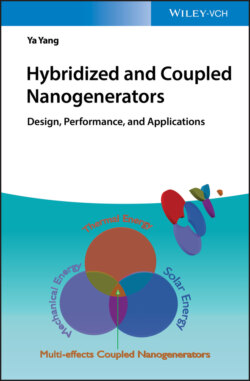Читать книгу Hybridized and Coupled Nanogenerators - Ya Yang - Страница 10
1 Overview 1.1 Introduction
ОглавлениеNanogenerators are based on the use of the displacement current of Maxwell as the driving force to convert environmental energies into electric signals, exhibiting various potential applications in wearable electronics, sensor systems, robotics, and other energy‐related science. Prof. Z. L. Wang and coworkers invented the first piezoelectric nanogenerator in 2006 [1], and invented the first triboelectric nanogenerator (TENG) in 2012 [2]. Both these nanogenerators are based on the polarization Ps produced due to the mechanical motions induced electrostatic surface charges, where it is not the electric field produced medium polarization P.
Usually, Maxwell's equations can be expressed by
(1.1)
(1.2)
(1.3)
(1.4)
where D is the electric displacement vector (D = ɛ0E + P). Z. L. Wang added an additional term Ps in D in 2017 [3,4]. Thus, D can be given as
(1.5)
where the polarization vector P is associated with the appearance of the external electric field, while the additional term Ps is associated with the appearance of the surface charges that can be independent of external electric fields [5]. Maxwell's displacement current is then expressed as
(1.6)
where the first term (electric field induced) is associated with the electromagnetic waves theory, while the added by Wang (called Wang term) is due to the non‐electric field‐induced, strain‐related polarization; this is the practical application of Maxwell's equations in the energies scavenging field as nanogenerators [5].
Various energies such as thermal, mechanical, chemical, and solar energies exist in the living environment. However, the occurrence of these energies depends on some working conditions such as weather or some other factors. The purpose of developing hybridized nanogenerators is to scavenge the different energies at the same time by integrating the different energy scavenging units into a system, so that we can obtain stable and sustainable power supply, regardless of whatever energy is available in the environment [6]. Prof. Z. L. Wang and coworkers invented the first hybrid energy cell in 2009 [7]. The first electromagnetic–triboelectric hybridized nanogenerator has been reported to scavenge one vibration energy by two different energy scavenging units in 2015 [8], which can largely enhance the efficiency of conversion from mechanical energy to electric energy. The existing hybridized nanogenerators are based on effectively stacking individual nanogenerators together in parallel or in series, where the individual nanogenerator has independent device structures and output electrodes. This is not suitable for miniaturization of the device dimension and for massive production. It is highly desirable to utilize multifunctional materials to obtain multi‐effects coupled nanogenerators with the same structure, material, and electrodes. By using piezo–tribo–pyro–photoelectric effects, Prof. Ya Yang and coworkers invented the first coupled nanogenerators in 2015 [9], which have the same materials, the same electrodes, and simultaneous different energies scavenging abilities. This book will give a detailed summary about the design, performance, and applications of the hybridized and coupled nanogenerators.
